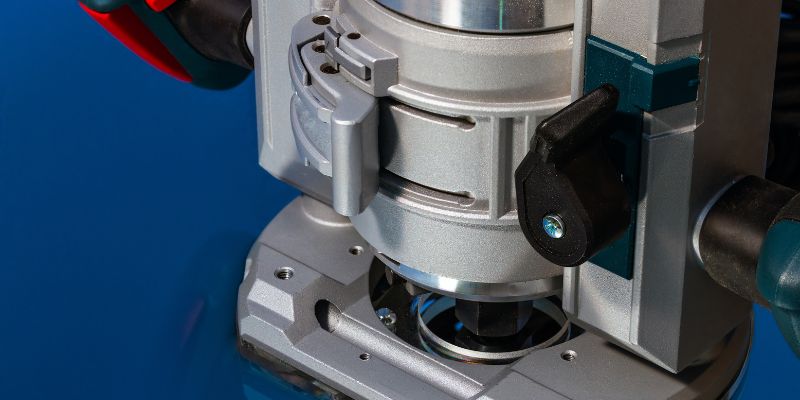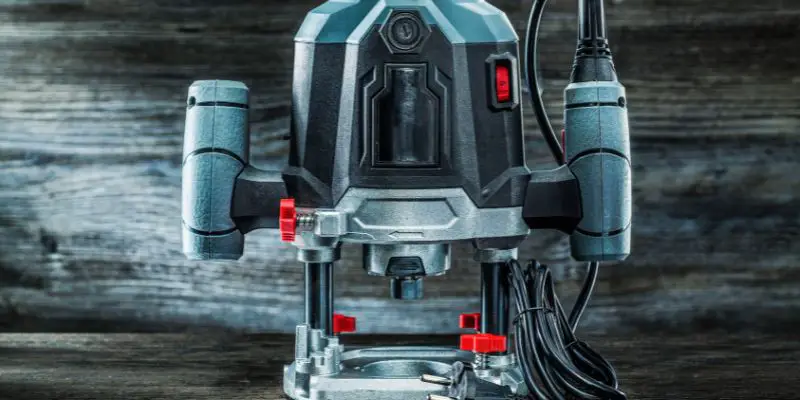When it comes to plunge vs trim routers, each tool has its own unique purpose. We will explore the differences between the two and help you understand which one is right for your woodworking projects.
Whether you need to make deep cuts or trim edges, both routers have their advantages and can be valuable additions to your workshop. By the end of this guide, you will have a clear understanding of when and how to use each tool effectively.
So let’s dive in and explore the world of plunge and trim routers!
Understanding Plunge Routers
When it comes to routing, plunge routers are a valuable tool that every woodworker should consider adding to their collection. Unlike trim routers, which are primarily used for cutting edges and trimming, plunge routers provide additional functionality that allows for greater precision and versatility in woodworking projects. In this section, we will explore what a plunge router is, its features and benefits, and how it compares to other types of power tools.
What Is A Plunge Router?
A plunge router, as the name suggests, is a type of router that allows the user to plunge the router bit into the workpiece vertically. This vertical movement can be controlled, providing the woodworker with the ability to make accurate and deep cuts, such as creating slots, mortises, and dados. Plunge routers are equipped with a spring-loaded base, which enables the user to lock the bit at a desired depth and then release it to cut into the material. This feature makes plunge routers especially useful for creating intricate designs and joinery.
Features And Benefits Of Plunge Routers
Plunge routers come with an array of features that make them indispensable tools in any woodworking workshop. Some key features and benefits of plunge routers include:
- Depth Control: Plunge routers offer precise depth control, allowing you to make accurate cuts at different depths.
- Variable Speed: Many plunge routers come with adjustable speed settings, giving you the flexibility to work with different materials and achieve different finishes.
- Micro Adjustments: Some plunge routers offer micro-adjustment features, which enable fine-tuning of the cutting depth for even greater precision.
- Easy Bit Changes: Plunge routers typically have a quick-release system that makes changing the router bits quick and effortless.
By incorporating these features, plunge routers provide woodworkers with the ability to create intricate designs, precise joinery, and complex cuts that are not easily achievable with other types of power tools.
Comparing Plunge Routers With Other Types Of Power Tools
While plunge routers offer a wide range of capabilities, it is important to understand how they compare to other types of power tools commonly used in woodworking. Here’s a brief comparison:
| Plunge Router | Fixed Base Router | Trim Router |
|---|---|---|
| Allows vertical plunging of the bit | Offers stability for edge routing | Designed for lightweight trimming and shaping tasks |
| Provides precise depth adjustments | Ideal for profiling edges and making dado cuts | Great for laminate trimming and small-scale projects |
| Offers versatility for creating joinery and intricate designs | Provides stability for router table applications | Compact and maneuverable for detailed work |
As seen in the comparison above, plunge routers offer unique advantages that set them apart from fixed-base and trim routers. Their ability to plunge, precise depth control, and versatility make them an essential tool for any serious woodworker.

Exploring Trim Routers
When it comes to woodworking, having the right tools can make all the difference in the precision and efficiency of your projects. One essential tool that every woodworker should have in their arsenal is a router. Among the various types of routers available, two popular options are the trim router and the plunge router. In this article, we will focus on trim routers and explore their characteristics, advantages, and limitations.
What Is A Trim Router?
A trim router, also known as a laminate trimmer, is a compact and lightweight router specifically designed for trimming and shaping edges of wood, laminate, or plastic materials. It is characterized by its smaller size and lower horsepower compared to its counterparts, making it ideal for jobs that require precision and maneuverability. Trim routers are typically handheld and feature a fixed base, which allows for more control and stability during intricate tasks.
Advantages And Limitations Of Trim Routers
Trim routers offer several advantages that make them a valuable addition to any woodworker’s toolkit:
- Portability: Due to their compact size and lightweight design, trim routers are highly portable. This makes them easy to maneuver and transport, allowing you to work on projects anywhere in your workshop or even on-site.
- Precision and Control: The smaller size of trim routers enables greater precision and control, especially when working on delicate or intricate details. Their fixed base ensures stability, reducing the chance of unintended movements that can compromise the quality of your work.
- Versatility: Despite their small size, trim routers can handle a wide range of tasks. They excel at edge trimming and profiling, inlaying, hinge mortising, and more. With the right accessories and bits, trim routers can be used for a variety of applications.
While trim routers offer many benefits, they also have some limitations that should be considered:
- Power: Due to their lower horsepower, trim routers may not be suitable for heavy-duty tasks that require deep cuts or working with harder materials. Plunge routers, on the other hand, are better equipped for such projects.
- Limited Depth Capacity: Trim routers are designed for trimming and shallow cuts, which means they have a limited depth capacity. If you require deeper cuts or routing grooves, a plunge router would be a more suitable choice.
- Smaller Collet Size: The collet size of a trim router is typically smaller than that of a plunge router. This means that certain router bits with larger shank diameters may not be compatible with trim routers.
Trim Routers Vs. Plunge Routers
While both trim routers and plunge routers are valuable tools in woodworking, their differences make each one better suited for specific tasks. The following table compares the main features of trim routers and plunge routers:
| Features | Trim Router | Plunge Router |
|---|---|---|
| Size | Compact | Relatively larger |
| Base | Fixed | Plunging capability |
| Horsepower | Lower | Higher |
| Depth Capacity | Shallow cuts | Deeper cuts |
| Versatility | Wide range of tasks | Heavy-duty tasks |
In conclusion, trim routers are versatile and maneuverable tools that excel at precision tasks, while plunge routers offer more power and depth capacity for heavy-duty applications. Depending on your woodworking needs and projects, you can choose the router that best suits your requirements. Both types have their place in a woodworker’s toolkit, and understanding their characteristics will help you make an informed decision.
Choosing The Right Power Tool For Your Needs
Choosing the right power tool for your woodworking projects is crucial in ensuring that you achieve precise and professional-looking results. Two popular options that woodworkers often contemplate when it comes to routing tasks are the plunge router and the trim router. Both of these power tools have their own unique features and advantages, which can make it challenging to decide which one is best suited for your needs. In this article, we will discuss the key considerations for different woodworking projects, the factors to think about when selecting between a plunge and trim router, and provide you with some tips to help you make an informed decision.
Considerations For Different Woodworking Projects
Woodworking projects can vary significantly in terms of complexity, size, and intricacy. Before deciding on which router to use, it’s important to consider the specific requirements of your project. Here are some key factors to keep in mind:
- The type of cuts you need to make – Are you creating dadoes, rabbets, or edge profiles?
- The size and thickness of the workpiece – Will you be working on large or small pieces of wood?
- The level of precision required – Are you working on intricate designs that demand precise control?
Factors To Consider When Selecting Between Plunge And Trim Routers
Now that you understand the considerations for different woodworking projects, let’s dive into the factors you should consider when choosing between a plunge router and a trim router:
- Depth control: One of the main differences between plunge and trim routers is the ability to adjust the cutting depth while the router is running. Plunge routers offer the advantage of allowing you to make plunge cuts and adjust the depth mid-cut, making them suitable for tasks like mortising and template routing. On the other hand, trim routers have limited depth adjustment capabilities, making them ideal for projects where consistent routing depth is required.
- Handling and maneuverability: Plunge routers are typically larger and heavier than trim routers. While this provides stability and control, it can be cumbersome for intricate projects that require plenty of maneuverability. Trim routers, being smaller and lighter, offer better handling in such situations.
- Bit visibility: Visibility of the cutting bit is vital for accurate routing. Plunge routers generally have better visibility due to their transparent base or the ability to lift the base during operation. Trim routers, though they may lack the transparency or lift feature, make up for it with their compact size, allowing for improved sightlines for routing.
- Versatility: Consider the range of tasks you plan to accomplish with your router. Plunge routers are more versatile, as they can be used for both plunge and non-plunge routing tasks. Trim routers, while limited in depth adjustment, excel in tasks that demand edge trimming, decorative routing, and small-scale jobs.
Tips For Making An Informed Decision
Now that you are aware of the considerations and factors when choosing between a plunge and trim router, here are some tips to keep in mind in order to make an informed decision:
- Assess your woodworking projects and determine the types of cuts and tasks you frequent most.
- Consider investing in both a plunge and trim router if your budget allows, as they serve different purposes and can complement each other.
- Read customer reviews and seek recommendations from experienced woodworkers to understand which router models perform well for specific tasks.
- Visit a local woodworking store or attend demonstrations to try out different models and get a feel for their handling and maneuverability.
- Take into account your own skill level and experience with routers, as plunge routers can be more challenging to master for beginners.
By carefully considering the requirements of your woodworking projects and evaluating the features and capabilities of different routers, you will be able to select the right power tool that suits your needs and enhances your woodworking skills.

Frequently Asked Questions For Plunge Vs Trim Router
Can You Trim Edges With A Plunge Router?
Yes, a plunge router can be used to trim edges.
What Is The Difference Between A Router And A Trim Router?
A router is a power tool used for shaping and hollowing out areas, while a trim router is a smaller version used for more precise trimming and shaping tasks. The main difference is in their size and power, with a trim router being more compact and suitable for lighter work.
Is A Plunge Router Better?
Yes, a plunge router is better because it allows for precise cutting at different depths, making it ideal for creating grooves, mortises, and decorative edges. It offers versatility and control, making it a preferred choice for woodworking tasks.
Which Is Better Palm Router Or Plunge Router?
The choice between a palm router and a plunge router depends on your needs. Palm routers are more compact and suitable for small tasks and intricate designs. Plunge routers are better for deep cuts and precise measurements with their adjustable plunge depth.
Consider the size and type of projects you’ll be working on to make the best decision.
Conclusion
When deciding between a plunge and trim router, it ultimately comes down to your specific woodworking needs. Consider the depth of cuts, versatility, and ease of use that each router offers. By understanding the differences and advantages of both options, you can choose the router that will best suit your projects.
So, whether you opt for the plunge router’s adjustable depth or the trim router’s compact size, make an informed decision for your woodworking endeavors.


